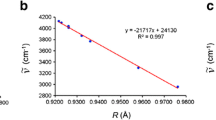Abstract
Zero-point energies (ZPE) and isotope effects, induced by intermolecular, noncovalent vibrations, are computed and tested by experimental data. The ZPE differences of H- and D-complexes of water with hydrogen, methane, and water molecules are about 100–300 cal/mol; they result to isotope effects IE of 1.20–1.70. Semi-ionic bonds between metal ions and water ligands in M(H2O) 2+6 complexes are much stronger; their ZPEs are about 12–14 kcal/mol per molecule and result to IE of 1.9–2.1 at 300 K. Protonated (deuterated) water and biwater exhibit the largest ZPE differences and isotope effects; the latter are 25–28 and 12–13 for water and biwater, respectively. Noncovalent IEs contribute markedly into the experimentally measured effects and explain many anomalous and even magic properties of the effects, such as the dependence of IE on the solvents and on the presence of the third substances, enormously large isotope effects at the mild conditions, the difference between IEs measured in the reactions of individual protiated and deuterated compounds and those measured in their mixture. Noncovalent IEs are not negligible and should be taken into account to make correct and substantiated conclusions on the reaction mechanisms. The kinetic equations are derived for the total isotope effects, which include noncovalent IEs as additive factors.
Similar content being viewed by others
References
D. Wade, Chem.-Biol. Interact. 117, 191 (1999)
L. Sobczyk, M. Obrzud, and A. Filarowski, Molecules 18, 4467 (2013).
A. L. Buchachenko and E. M. Pliss, Russ. Chem. Rev. 85, 557 (2016).
M. Turowski, N. Yamakawa, J. Meller, J. Kimata, K. Ikegami, T. Hosoya, N. Tanaka, and E. Thornton, J. Am. Chem. Soc. 125, 13836 (2003).
D. Rechavi, A. Scarso, and J. Rebek, Jr., J. Am. Chem. Soc. 126, 7738 (2004).
T. Haino, K. Fukuta, H. Iwamoto, and S. Iwata, Chem. Eur. J. 15, 13286 (2009).
C. N. Filler and J. Label, Compound Radiopharm. 42, 169 (1999).
A. Valleix, S. Carrat, C. Caussignac, E. Leonce, and A. Tchapla, J. Chromatogr. A 1116, 109 (2006).
Y. Zhao and D. G. Truhlar, J. Phys. Chem. A 109, 5656 (2005).
R. A. Kendall, T. H. Dunning, Jr., and R. J. Harrison, J. Chem. Phys. 96, 6796 (1992).
E. R. Kevin, M. Pitonak, P. Jurecka, and P. Hobza, Chem. Rev. 110, 5023 (2010).
I. K. Ortega, A. Määttänen, T. Kurtén, and H. Vehkamäki, Comput. Theor. Chem. 965, 353 (2011).
C. N. Ramachandran and E. Ruckenstein, Comput. Theor. Chem. 966, 84 (2011).
J. Ceponkus, P. Uvdal, and B. Nelander, J. Chem. Phys. 129, 194306 (2008).
N. Frank, J. Keutsch, D. Cruzan, and R. J. Saykally, Chem. Rev. 103, 2533 (2003).
Y. Abate and P. D. Kleibe, J. Chem. Phys. 122, 084305 (2005).
W. L. Pearson, C. Copeland, A. Kocak, S. Zallese, and R. B. Metz, J. Chem. Phys. 141, 204305 (2014).
CRC Handbook of Chemistry and Physics, Ed. by W. M. Haynes, 94th ed. (CRC, Boca Raton, FL, 2013).
M. V. Vener and N. B. Librovich, Int. Rev. Phys. Chem. 28, 407 (2009).
O. Vendrell, F. Gatti, and H.-D. Meyer, J. Chem. Phys. 131, 034308 (2009).
J. P. Klinman, Chem. Phys. Lett. 471, 179 (2009).
J. P. Layfield and Sh. Hammes-Schiffer, Chem. Rev. 114, 346 (2014).
Author information
Authors and Affiliations
Corresponding author
Rights and permissions
About this article
Cite this article
Buchachenko, A.L., Breslavskaya, N.N. Noncovalent Hydrogen Isotope Effects. Russ. J. Phys. Chem. 92, 315–320 (2018). https://doi.org/10.1134/S003602441802005X
Received:
Published:
Issue Date:
DOI: https://doi.org/10.1134/S003602441802005X




